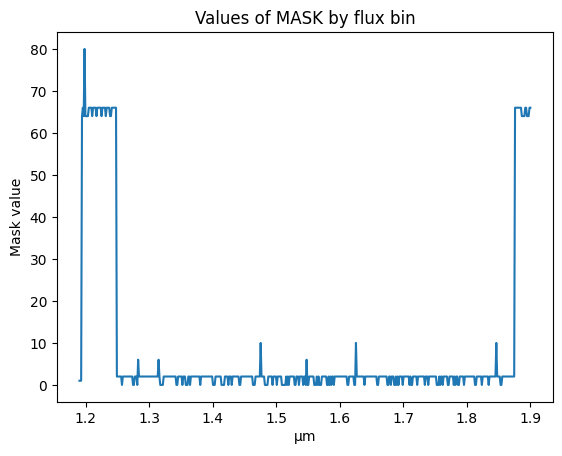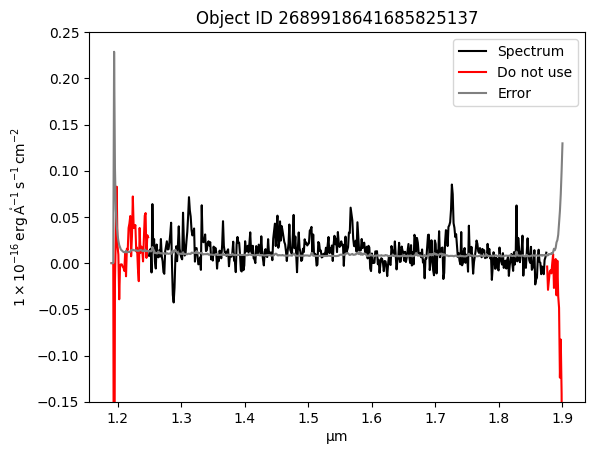Learning Goals¶
By the end of this tutorial, you will:
Understand the basic characteristics of Euclid Q1 SIR 1D spectra.
What columns are available in the MER catalog.
How to query with ADQL in the MER catalog.
How to make a simple color-magnitude diagram with the data.
Introduction¶
Euclid launched in July 2023 as a European Space Agency (ESA) mission with involvement by NASA. The primary science goals of Euclid are to better understand the composition and evolution of the dark Universe. The Euclid mission is providing space-based imaging and spectroscopy as well as supporting ground-based imaging to achieve these primary goals. These data will be archived by multiple global repositories, including IRSA, where they will support transformational work in many areas of astrophysics.
Euclid Quick Release 1 (Q1) consists of consists of ~30 TB of imaging, spectroscopy, and catalogs covering four non-contiguous fields: Euclid Deep Field North (22.9 sq deg), Euclid Deep Field Fornax (12.1 sq deg), Euclid Deep Field South (28.1 sq deg), and LDN1641.
Among the data products included in the Q1 release are the 1D spectra created by the SIR Processing Function. This notebook provides an introduction to these SIR 1D spectra. If you have questions about it, please contact the IRSA helpdesk.
Imports¶
# Uncomment the next line to install dependencies if needed
# !pip install matplotlib astropy 'astroquery>=0.4.10'import numpy as np
import matplotlib.pyplot as plt
from astropy.io import fits
from astropy.table import QTable
from astropy import units as u
from astropy.visualization import quantity_support
from astroquery.ipac.irsa import Irsa1. Search for the spectrum of a specific galaxy¶
First, explore what Euclid catalogs are available. Note that we need to use the object ID for our targets to be able to download their spectrum.
Search for all tables in IRSA labeled as “euclid”.
Irsa.list_catalogs(filter='euclid'){'euclid_q1_mer_catalogue': 'Euclid Q1 MER Catalog'}table_1dspectra = 'euclid.objectid_spectrafile_association_q1'2. Search for the spectrum of a specific galaxy in the 1D spectra table¶
obj_id = 2689918641685825137We will use TAP and an ASQL query to find the spectral data for our galaxy. (ADQL is the IVOA Astronomical Data Query Language and is based on SQL.)
adql_object = f"SELECT * FROM {table_1dspectra} WHERE objectid = {obj_id}"
# Pull the data on this particular galaxy
result = Irsa.query_tap(adql_object).to_table()Pull out the file name from the result table:
spectrum_path = f"https://irsa.ipac.caltech.edu/{result['path'][0]}"
spectrum_path'https://irsa.ipac.caltech.edu/api/spectrumdm/convert/euclid/q1/SIR/102160608/EUC_SIR_W-COMBSPEC_102160608_2024-11-05T16:42:00.741819Z.fits?dataset_id=euclid_combspec&hdu=321'3. Read in the spectrum for only our specific object¶
spectrum_path is a url that will return a VOTable containing the spectrum of our object.
spectrum = QTable.read(spectrum_path)WARNING: UnitsWarning: The unit 'Angstrom' has been deprecated in the VOUnit standard. Suggested: 0.1nm. [astropy.units.format.base]
WARNING: UnitsWarning: The unit 'erg' has been deprecated in the VOUnit standard. Suggested: cm**2.g.s**-2. [astropy.units.format.base]
WARNING: UnitsWarning: The unit 'Angstrom' has been deprecated in the VOUnit standard. Suggested: 0.1nm. [astropy.units.format.base]
WARNING: UnitsWarning: The unit 'erg' has been deprecated in the VOUnit standard. Suggested: cm**2.g.s**-2. [astropy.units.format.base]
WARNING: UnitsWarning: The unit 'Angstrom' has been deprecated in the VOUnit standard. Suggested: 0.1nm. [astropy.units.format.base]
WARNING: UnitsWarning: The unit 'erg' has been deprecated in the VOUnit standard. Suggested: cm**2.g.s**-2. [astropy.units.format.base]
WARNING: UnitsWarning: The unit 'Angstrom' has been deprecated in the VOUnit standard. Suggested: 0.1nm. [astropy.units.format.base]
spectrum4. Plot the image of the extracted spectrum¶
quantity_support()<astropy.visualization.units.quantity_support.<locals>.MplQuantityConverter at 0x7f5f1af8fc20>We investigate the MASK column to see which flux bins are recommended to keep vs “Do Not Use”
plt.plot(spectrum['WAVELENGTH'].to(u.micron), spectrum['MASK'])
plt.ylabel('Mask value')
plt.title('Values of MASK by flux bin')
We use the MASK column to create a boolean mask for values to ignore. We use the inverse of this mask to mark the flux bins to use.
bad_mask = (spectrum['MASK'].value % 2 == 1) | (spectrum['MASK'].value >= 64)
plt.plot(spectrum['WAVELENGTH'].to(u.micron), np.ma.masked_where(bad_mask, spectrum['SIGNAL']), color='black', label='Spectrum')
plt.plot(spectrum['WAVELENGTH'], np.ma.masked_where(~bad_mask, spectrum['SIGNAL']), color='red', label='Do not use')
plt.plot(spectrum['WAVELENGTH'], np.sqrt(spectrum['VAR']), color='grey', label='Error')
plt.legend(loc='upper right')
plt.ylim(-0.15, 0.25)
plt.title(f'Object ID {obj_id}')
About this Notebook¶
Author: Tiffany Meshkat, Anahita Alavi, Anastasia Laity, Andreas Faisst, Brigitta Sipőcz, Dan Masters, Harry Teplitz, Jaladh Singhal, Shoubaneh Hemmati, Vandana Desai, Troy Raen
Updated: 2025-09-23
Contact: the IRSA Helpdesk with questions or reporting problems.